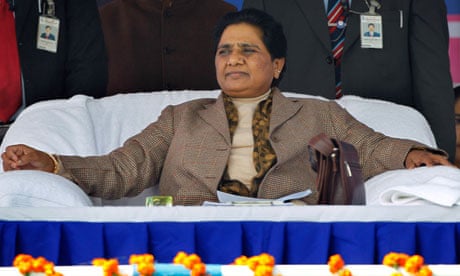When they hear the helicopter, the women, impassive during the previous hour of speeches, start to move. It hovers above them and they stand on their seats; when it lands, blasting a wave of dirt that pulls at their cheap nylon saris, they raise their arms. "Behenji zindabad! Long live our loved and respected sister!" they shout.
A fancy 4x4 vehicle approaches the helicopter, and a short, dowdy 56-year-old woman in a thick brown coat steps from the aircraft. The car drives her the 50 metres to where the wellwishers wait, and then Mayawati Kumari – "Behenji" (sister) to her supporters and a dangerous, megalomanic populist to her critics – waves to the crowd and sits down on the sofa placed centre stage.
Mayawati, who usually goes by just the one name, is seeking a second five-year term as the chief minister of Uttar Pradesh, India's most populous state. The state is so large – with a population of 190 million, it would be the fifth biggest country in the world if independent – that the polls, which open on Wednesday, are staggered over a month to allow sufficient security forces to be deployed.
The logistical difficulties are exacerbated by extreme poverty. Apart from where Uttar Pradesh abuts the capital Delhi, the new "Shining India" is nowhere to be seen. Instead, poverty levels are worse than much of sub-Saharan Africa. There is violence and discrimination, particularly on the basis of caste – the ancient but tenacious social hierarchy based originally on occupation – but also due to gender.
While politics here is often violent and corrupt, the votes of the women in their cheap multi-coloured saris do matter – which is why Mayawati has travelled to Gonda, a small town in the north of the state, to talk to them.
Forbidden
Mayawati was born in 1956 in a village at the other end of Uttar Pradesh, 400 miles away. She is, to use a local word denoting local, authentic, south Asian or Indian, thoroughly desi. Her father was a low-ranking government clerk. He was also a Dalit, from the lowest group of castes in the hierarchy. Once known as untouchables, the Dalits, despite huge affirmative action programmes in recent decades, still face deep discrimination.
While less evident in the big cities visited by most tourists (though most menial staff at hotels are Dalit), in the villages they usually till land owned by higher castes but live separately, often forbidden to share the village's well, school or cemetery. It was in such a village that Mayawati was born.
By the time she was eight, her family had moved to a resettlement colony for Dalits outside Delhi, Jugghi Jupri colony or Shack Township, which had no sanitation or power. Now the colony is part of Delhi's vast sprawl: the scrubby wasteland where former neighbours describe Mayawati tending the family's four buffaloes is long gone. There are now about 100,000 people crammed into teetering six storey tenements. Sewage flows through narrow lanes and hawkers sell fruit among cows rummaging through plastic bags. The proportion of Dalits remains the same, said Mann Chand, a hawker there since 1972.
Ganga Warsi, 55, still lives opposite where Mayawati spent most of her childhood, a small plot now occupied by a tenement. He remembers the second sibling of three girls and six boys as being serious and feisty: "I never saw her playing. Between school, the buffalo and housework, there was not much time."
Mayawati already knew what caste meant. Her family was "chamar", tanners and leatherworkers – among the most unclean of all. Warsi recalled how a teenage Mayawati was shooed away from a communal tap because she was a chamar.
"She got into a huge fight. And it happened often. People would try not to get in an argument with her," Warsi said.
Politics was an uncertain path without prestige, and her father pushed the young Mayawati to study for civil service exams. A diligent but not particularly inspired student, according to biographer Ajoy Bose, she took on part-time teaching work in private colleges to pay for her own further education.
At 21, however, came an epiphany. The late 1960s and 70s had seen a growing political mobilisation of Dalits. In Jugghi Jupri colony, regular meetings were held to read the works and celebrate the life of Bhimrao Ambedkar, a Dalit leader and jurist who had drafted much of the Indian constitution.
At one such event, held in the scruffy brick community centre which still stands, Mayawati, in an astonishing breach of the code of deference in Indian society, harangued an older, male, upper caste, senior politician from the dominant Congress party. His party had done nothing for people like her except patronise them, she told him.
News of the scene reached a charismatic fringe activist for Dalit rights called Kanshi Ram. Nearly 20 years older than Mayawati, he was to forge a close, though probably platonic, partnership with her. After meeting Kanshi Ram, who died in 2006, Mayawati in effect disowned her father, left her studies and moved in with her political mentor. "It was a scandal," said Bala Ram, 60, a family friend.
There followed 10 years of political activism, its agenda was supposedly national but focused increasingly on Uttar Pradesh.
This was logical. Not only was Mayawati from the state but the vast, desperately poor swath of land from Delhi along the northern plains was fertile political ground.
In 1984 Kanshi Ram formed the Bahujan Samaj ("people in majority") Party (BSP). The name refers to all those who are not high caste – described in BSP literature as exploitative oppressors. The party met with relatively rapid success. Affirmative action and steady if slow economic growth had created a new class of educated Dalits. These gravitated to the party. But it was by addressing thousands of meetings, often cycling from one to the other, and mobilising the very poor that Mayawati made her breakthrough.
Votes from the Muslim community, often as disadvantaged as the Dalits, helped. Though early attempts failed, by 1989 Mayawati had won a seat in the national assembly, the Lok Sabha, where her casual dress, popular language, traditionally oiled hair and often aggressive posturing met with contemptuous indignation from the established, often upper caste elite who still dominated Indian politics. Some complained that Mayawati smelled of sweat.
The real focus of her campaign however remained Uttar Pradesh. Politics in the state is a chaotic melée of caste, religion, money and brute strength. In 1995 a fortuitous arrangement of votes and tactical alliances made Mayawati chief minister of Uttar Pradesh for the first time. Though described as "a miracle of democracy" by the then prime minister, her reign lasted only three months. She had just long enough to give hundreds of Dalits official posts and commission a vast new park in honour of famous Dalits in central Lucknow, the state capital. She also purged the police force and enforced laws against caste-based violence.
In 1997, Mayawati was back, though for only six months. In 2002, came a third stint in charge, this time lasting just over a year. Finally in 2007, after almost exactly two decades of brutal, messy, complex political manoeuvring and activism, the BSP, already a power broker at a national level, won a landslide victory in Uttar Pradesh.
Those who have worked with her describe her political tactics as blunt in the extreme. "The shortest route from A to B, always, and with maximum application of effort," said a former aide. The methods were apparently effective. There was even a moment when she was spoken of as a potential prime minister in 2009.
But in her five years of power, critics say, Mayawati has become like other rulers. She is thus now likely to suffer from the powerful swing against incumbents common in Indian politics. She has cut herself off from the masses, reporters in the state say, and lives in a vast Lucknow residence which, like her party HQ next door, has high walls and gun turrets. Few personal details are known about her.
She is unmarried, is not known to have any sentimental attachment, sees her family infrequently and has no known pastimes. She relies on a few key lieutenants. Dissent from a bureaucrat, let alone a party worker, is not tolerated. The final word is always hers. There is no cabinet as such. There is little consultation.
"She shows a mix of megalomania and paranoia," said Ramachandra Guha, a historian and political analyst. "She believes everyone is out to get her but she can beat them."
Edifice
The most visible signs she will leave if ousted are the extraordinary monuments she has had built. These are vast, featuring huge expanses of marble, red sandstone elephants (the BSP symbol), a giant mausoleum flanked by vast staircases and 15 metre statues of Mayawati wearing a coat and carrying a handbag.
Outside one such edifice, now encased in plywood by election commissioners to avoid swaying voters, a Dalit art student made the obvious point that the money would have been better spent on schools. But the literate and politically conscious student was not necessarily representative of the tens of millions of other Dalits who see the parks as a testament to Mayawati's "zero to hero" story.
"She makes me proud. I will vote for her and my children will vote for her when she's gone," said a cobbler who had travelled for a day to see one newly opened monument in the city of Noida.
Her personal wealth – Mayawati is now immensely rich – is justified similarly. She appears festooned in diamonds. All her wealth, said RA Mittal, a BSP organiser in Lucknow, came from donations "to the cause" from her supporters. As she has no children, the funds would be returned when she died so there was no impropriety, he explained.
Mayawati still has huge support in Uttar Pradesh but her rallies have so far been lacklustre and the polls are not positive. Hundreds were filing out of the Gonda event well before the end despite the prospect of watching the helicopter take off. "She's done nothing for us," said one 64-year-old woman. Others admitted to having been paid to attend.
Yet Puja, 18, carefully listed the chief minister's achievements. "Behenji is the tallest leader for the Dalit community – that is why we are all behind her, all of us," she said and burst into tears.
CV
Born 15 January 1956
Career Astonishing, given her background. Mayawati has overcome the twin obstacles of being a low-caste woman to win – and hold – power in India's most populous state and exercise significant influence at a national level as well.
High point Her 2003 birthday, marked during third term as chief minister with a 51kg cake, giant Bollywood stage set and 5,000 bouquets of flowers.
Low point Sheltering in a government guesthouse as a mob organised by her main political opponent attempted to force entry while the police stood aside.
What she says Very little, as she gives almost no media interviews.
What they say A US cable titled Portrait of a Lady, sent by the US Embassy in Delhi in October 2008, refers to "a virtual paranoid dictator replete with food tasters and a security entourage to rival a head of state" who sent a private jet to Mumbai, the Indian commercial capital, to fetch her favourite brand of sandals.

